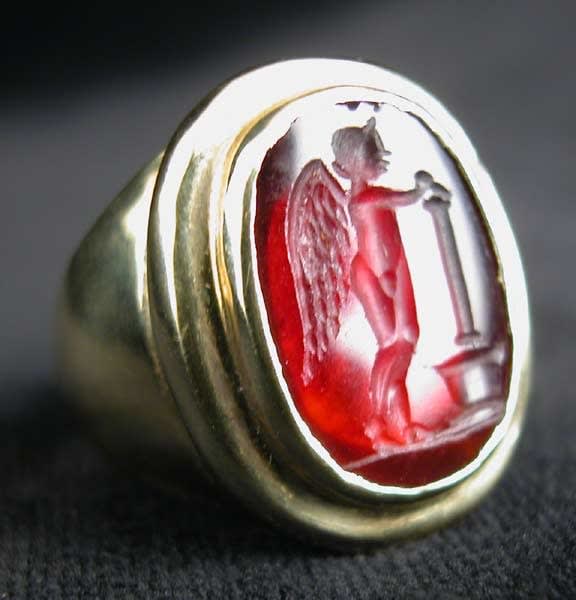Gold Ring with Classical Revival Carnelian Intaglio of Cupid, 18th Century CE
Carnelian and Gold
FJ.6737
Further images
This Stunning Intaglio Has Been Set in a Modern 18 Karat Gold Ring. Cupid was the celebrated god of love in Roman mythology. The name Cupid is a variation on...
This Stunning Intaglio Has Been Set in a Modern 18 Karat Gold Ring.
Cupid was the celebrated god of love in Roman mythology. The name Cupid is a variation on the word “cupido” (desire), and this god was also known by the name Amor (Love). It was commonly believed that Cupid was the child of Venus, the Roman goddess of love, and this association between Venus and Cupid was often reinforced in popular myths, poetry, literature, and art.
Created during the 18th Century, this intaglio is the product of the Classical Revival, a period where modern Europe looked towards the past and reinterpreted the forms and arts of ancient Greece and Rome anew. The art of glyptics, or carving images on precious stones, is one of the oldest art forms known to man. The sudden resurrection of the glyptic arts in modern Europe reveals their obsession with recreating the masterpieces of antiquity. This sudden interest in the past is probably a product of the rapid industrial and urban growth experienced during this era. As the realities of city life sank in, surely one would longingly dream of the past and seek to rekindle the pastoral lifestyle left behind. Breakthroughs in scientific understanding in the nascent field of archaeology surely further fueled the popularity of the Classical Revival as well.
Love as embodied by mischievous Cupid manipulates the vulnerability and desperation of anguished lovers. Cupid carelessly plays with our hearts as if they were his toys. However, when one wears this ring, it demonstrates a restraint over the wilder impulses of lover. On our fingers, Cupid is no longer devious, but an emblem of the beauty and joys of love.
Cupid was the celebrated god of love in Roman mythology. The name Cupid is a variation on the word “cupido” (desire), and this god was also known by the name Amor (Love). It was commonly believed that Cupid was the child of Venus, the Roman goddess of love, and this association between Venus and Cupid was often reinforced in popular myths, poetry, literature, and art.
Created during the 18th Century, this intaglio is the product of the Classical Revival, a period where modern Europe looked towards the past and reinterpreted the forms and arts of ancient Greece and Rome anew. The art of glyptics, or carving images on precious stones, is one of the oldest art forms known to man. The sudden resurrection of the glyptic arts in modern Europe reveals their obsession with recreating the masterpieces of antiquity. This sudden interest in the past is probably a product of the rapid industrial and urban growth experienced during this era. As the realities of city life sank in, surely one would longingly dream of the past and seek to rekindle the pastoral lifestyle left behind. Breakthroughs in scientific understanding in the nascent field of archaeology surely further fueled the popularity of the Classical Revival as well.
Love as embodied by mischievous Cupid manipulates the vulnerability and desperation of anguished lovers. Cupid carelessly plays with our hearts as if they were his toys. However, when one wears this ring, it demonstrates a restraint over the wilder impulses of lover. On our fingers, Cupid is no longer devious, but an emblem of the beauty and joys of love.





